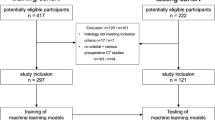Abstract
Purpose
The aim of this study was to assess whether the pancreatic phase may replace the arterial phase in the evaluation of endocrine pancreatic tumours.
Materials and methods
Twenty-nine endocrine pancreatic lesions with definitive morphological and immunohistochemical characterisation after surgical treatment (n=24) or fine-needle-aspiration cytology under endoscopic ultrasonography guidance (n=5) were retrospectively evaluated. All lesions were studied with triple-phase 16-row multidetector computed tomography (MDCT). Images obtained during each phase were separately interpreted by two senior radiologists experienced in pancreatic pathology and who were blinded to surgical results. Endocrine tumour and normal pancreas attenuation and the mean absolute tumour-to-gland attenuation difference were measured in each phase, and data were analysed with Student’s t test. Visualisation of arterial vascular abnormalities and hypervascular liver metastases in the arterial and pancreatic phases and the diagnostic contribution of the two phases were compared.
Results
For both radiologists, the mean absolute tumour-to-gland attenuation difference was significantly higher (p<0.05) in the pancreatic phase (40±53 HU and 34±56 HU) than in the arterial phase (31±38 HU and 26±43 HU). There were no differences in the detection of arterial vascular abnormalities or hypervascular liver metastases in the two phases. The diagnostic contribution was higher in the pancreatic phase.
Conclusions
In our experience, the pancreatic phase can replace the arterial phase in the evaluation of pancreatic endocrine tumours.
Riassunto
Obiettivo
Determinare se la fase pancreatica possa sostituire quella arteriosa nella valutazione di tumori endocrini pancreatici.
Materiali e metodi
Sono state valutate retrospettivamente 29 lesioni endocrine pancreatiche, con diagnosi definitiva alla valutazione morfologica e immuno-istochimica, dopo trattamento chirurgico (n=24) o prelievo citologico sotto guida ecoendoscopica (n=5). Tutte le lesioni sono state studiate con MDCT (16 canali), con tecnica trifasica. Le immagini ottenute in ciascuna fase sono state interpretate da due radiologi, esperti in patologia pancreatica, all’oscuro delle diagnosi definitive, valutando le densità di ghiandola pancreatica e tumore e la differenza di attenuazione tumore-ghiandola in valore assoluto, in ogni fase; i dati ottenuti sono stati analizzati con il test t di Student. Sono state inoltre confrontate la capacità delle due fasi nel visualizzare anomalie vascolari arteriose e metastasi epatiche ipervascolari e il loro contributo alla confidenza diagnostica.
Risultati
Per entrambi i radiologi il valore assoluto della differenza di attenuazione tumore-ghiandola in fase pancreatica (40±53 HU e 34±56 HU) è risultata significativamente maggiore (p<0,05) di quella ottenuta in fase arteriosa (31±38 HU e 26±43 HU). Non c’era differenza nella detezione di anomalie vascolari arteriose e metastasi epatiche ipervascolari nelle due fasi. Il contributo della fase pancreatica alla confidenza diagnostica era maggiore.
Conclusioni
Nella nostra esperienza la fase pancreatica può sostituire quella arteriosa nella valutazione di tumori endocrini pancreatici.
Similar content being viewed by others
References/Bibliografia
Ichikawa T, Peterson MS, Federle MP et al (2000) Islet cell tumor of the pancreas: biphasic CT versus MR imaging in tumor detection. Radiology 216:163–171
Zimmer T, Ziegler K, Bader M et al (1994) Localisation of neuroendocrine tumours of the upper gastrointestinal tract. Gut 35:471–475
Anderson MA, Carpenter S, Thompson NW et al (2000) Endoscopic ultrasound is highly accurate and directs management in patients with neuroendocrine tumors of the pancreas. Am J Gastroenterol. 95:2271–2277
Fidler JL, Fletcher JG, Reading CC et al (2003) Preoperative detection of pancreatic insulinomas on multiphasic helical CT. AJR Am J Roentgenol 181:775–780
Stabile Ianora AA, Muscogiuri E, Scardapane A et al (2004) Multislice CT in the study of insulinomas: preliminary experience. Radiol Med 107:325–331
Takeshita K, Kutomi K, Takada K et al (2005) 3D Pancreatic arteriography with MDCT during intraarterial infusion of contrast material in the detection and localization of insulinomas. AJR Am J Roentgenol 184:852–854
House MG, Yeo CJ, Cameron JL et al (2004) Predicting resectability of periampullary cancer with three-dimensional computed tomography. J Gastrointest Surg. 8:280–288
Lepanto L, Arzoumanian Y, Gianfelice D et al (2002) Helical CT with CT angiography in assessing periampullary neoplasms: identification of vascular invasion. Radiology 222:347–352
Horton KM, Hruban RH, Yeo C et al (2006) Multi-detector row CT of pancreatic islet cell tumors, Radiographics 26:453–464
Lu DSK, Vedantham S, Krasny RM et al (1996) Two-phase helical CT for pancreatic tumors: pancreatic versus hepatic phase enhancement of tumor, pancreas and vascular structures. Radiology 199:697–701
Boland GW, O’Malley ME, Saez M et al (1999) Pancreatic-phase versus portal vein-phase helical CT of the pancreas: optimal temporal window for evaluation of pancreatic adenocarcinoma. AJR 172:605–608
Hollett MD, Jorgensen MJ, Jeffrey RB (1995) Quantitative evaluation of pancreatic enhancement during dual-phase helical CT. Radiology 195:359–361
Fletcher JG, Wiersema MJ, Farrell MA et al (2003) Pancreatic malignancy: value of arterial, pancreatic, and hepatic phase imaging with multi-detector row C. Radiology 229:81–90
Noone TC, Hosey J, Firat Z et al (2005) Imaging and localization of islet-cell tumours of the pancreas on CT and MRI. Best Pract Res Clin Endocrinol Metab 19:195–211
King AD, Ko GTC, Yeung VTF et al (1998) Dual phase CT in the detection of small insulinomas of the pancreas. Br J Radiol 71:20–23
Gouya H, Vignaux O, Augui J et al (2003) CT, endoscopic sonography, and a combined protocol for preoperative evaluation of pancreatic insulinomas. AJR Am J Roentgenol 181:987–992
Solcia E, Kloppel G, Sobin LH (2000) Histological typing of endocrine tumours. Springer 56–59
Raptopoulos V, Steer ML, Sheiman RG et al (1997) The use of helical CT and CT angiography to predict vascular involvement from pancreatic cancer: correlation with findings at surgery. AJR Am J Roentgenol 168:971–977
Lu DSK, Reber HA, Krasny RM et al (1997) Local staging of pancreatic cancer: criteria for unresectability of major vessels as revealed by pancreatic phase, thin-section helical CT. AJR Am J Roentgenol 168:1439–1443
Author information
Authors and Affiliations
Corresponding author
Rights and permissions
About this article
Cite this article
Gusmini, S., Nicoletti, R., Martinenghi, C. et al. Arterial vs pancreatic phase: which is the best choice in the evaluation of pancreatic endocrine tumours with multidetector computed tomography (MDCT)?. Radiol med 112, 999–1012 (2007). https://doi.org/10.1007/s11547-007-0201-1
Received:
Accepted:
Published:
Issue Date:
DOI: https://doi.org/10.1007/s11547-007-0201-1




